Is Squeezing Through Naked People Really Art?
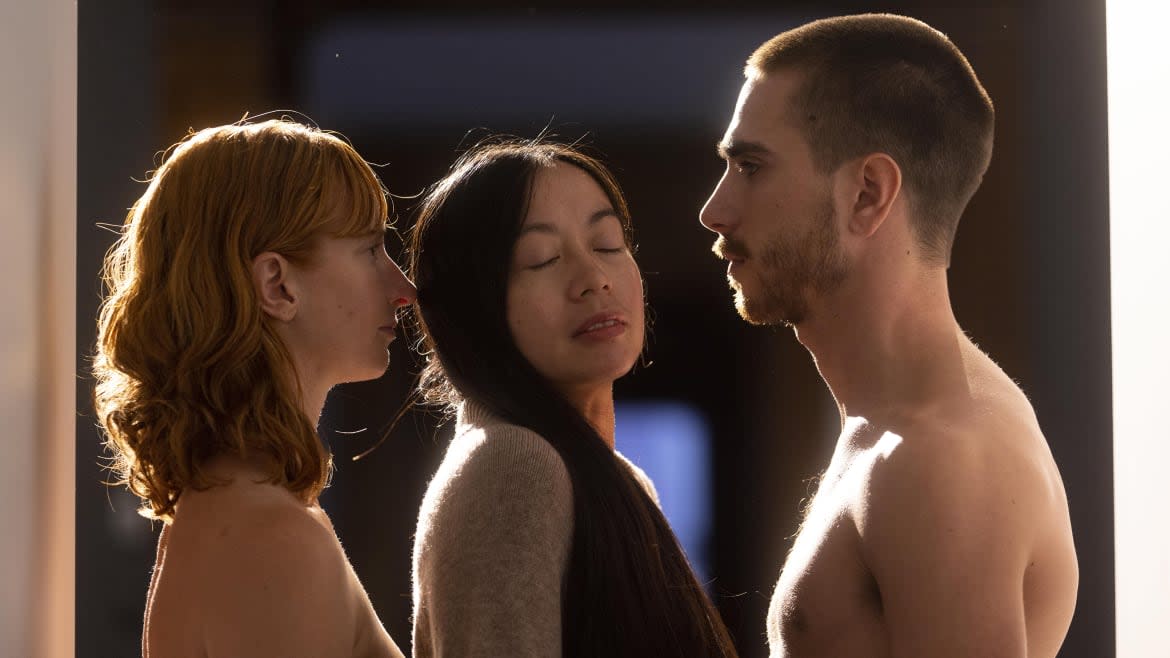
- Oops!Something went wrong.Please try again later.
- Oops!Something went wrong.Please try again later.
The first time the world was treated to Marina Abramović’s Imponderabilia, in an Italian art gallery in 1977, the police arrived and shut the performance down on the grounds of obscenity. The former Yugoslavia-born artist and her partner, Ulay, stood opposite each other naked at the gallery’s entrance, close enough that visitors were required to squeeze between their nude bodies to enter. The planned six-hour performance was forced to end after just three. But don’t worry if you missed it—or its 2010 redux—it’s now back as part of an exhibition of Abramović’s work at the Royal Academy of Arts (RA) in London.
Born in Belgrade in 1946, Abramović studied as an academic painter before surging to international fame for her pioneering and often disturbing performance artworks beginning in the 1970s. Her work, which has notoriously involved putting herself in harm’s way—even mortal danger—has cemented her reputation over the last half-century as an iconoclast and the acclaimed “grandmother of conceptual art.”
The Abramović exhibition is, astonishingly, the first solo show by a female artist in the RA’s Main Galleries (the RA’s history dates to the 18th century), arriving even later than organizers had originally planned. Initially scheduled to open in 2020, COVID gave curators no choice but to postpone a show whose centerpiece is predicated on the most radical departure conceivable from the idea of social distancing. After two reschedulings, the doors opened—and the clothes came off—at the exhibition last month. Better late than never.
Mercifully, the RA’s exhibition is structured such that visitors do actually get a chance to acclimate to Abramović’s unsettling oeuvre before being confronted with Imponderabilia, which is now performed by a rotating cast of male-and-female pairs of “re-performers” in the place of the now 76-year-old Abramović and Ulay (who died in 2020).
In the first room, we see recordings from The Artist Is Present, Abramović’s 2010 piece performed at MoMA in New York, in which over 1,500 people took it in turns to sit opposite Abramović and silently stare into her eyes for an indeterminate length of time. On one wall, we see projections of the visitors’ facial expressions—some, visibly uncomfortable, can’t help but smirk; others, overwhelmed, openly weep. On the opposite wall are projections of the artist’s face as she sits looking back blankly at each of her unspeaking interlocutors, unerringly regarding each of them the same way she might a utility bill.
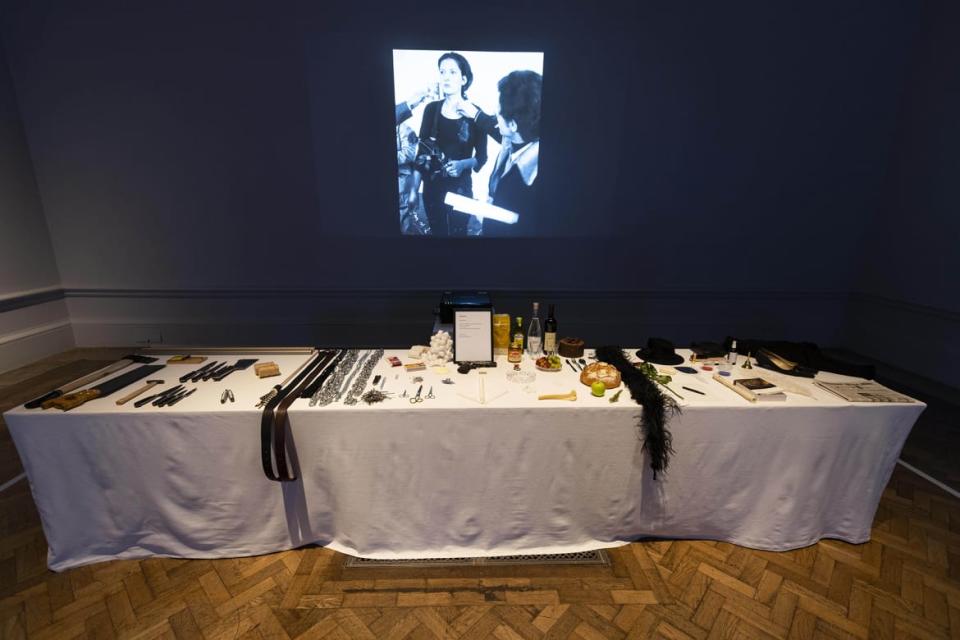
Marina Abramović's Rhythm at the Royal Academy of Arts.
Further into the exhibition, the signature extremity of Abramović’s work is on full show. An audio-visual display shows Abramović’s Rhythm 10 (1973), in which she plays the knife game sometimes called five finger fillet, spreading her left hand on a piece of paper and using her right to stab, as quickly as possible, in the spaces between her splayed fingers, repeatedly cutting herself and bleeding in front of what must have been a deeply distraught audience. She later said that, after that performance, “I knew that I had found my medium.”
That medium, it turns out, is prolonged discomfort, pushing the physical limits of her body in the service of a perceived higher ideal. In the process, she’s become something like the thinking man’s David Blaine: a performer prepared to undergo lengthy feats of agony for an audience who can’t look away. But while Blaine enjoyed a primetime audience as he nearly drowned on the Oprah Winfrey Show, Abramović has built her reputation for the extreme in the narrower gaze of the art world’s intelligentsia. All artists may be prepared to suffer for their work, but few have suffered like Abramović.
In one room, we find a table topped with 72 objects—including a saw, an ax, and a gun—the same array of items that was offered to the audience of Rhythm 0 in Naples in 1974. “I am the object,” Abramović’s instructions to visitors read at the time. “During this period I take full responsibility.” As upsetting images accompanying the objects show, the performance had truly traumatizing results—the public cut off her clothes, slashed her skin, and put the gun in her hand and pointed it at her neck. Abramović later said the experience left her afraid, and turned part of her hair white.
The following year, she met the German artist Ulay (real name Frank Uwe Laysiepen) for the first time. Ulay shared a birthday—November 30—with Abramović, as well as an apparent appreciation for her Saw-like sensibility. At the RA, the bitter fruits of their collaboration are on display; unsettling images show them screaming in each other’s faces, trading slaps, and taking part in one performance which involved Ulay using a needle and thread to sew his own lips shut. A video shows their 1980 performance Rest Energy, in which the artists used the weight of their bodies to draw a bow loaded with an arrow pointing directly at Abramović’s heart, such that a small slip could kill her. The performance only lasted a few minutes, but every second is unbearable to watch.
What Makes Marina Abramović’s Art So Extreme?
After being exposed to the body horror of Abramović’s early work, visitors are ultimately invited to take part in something deeply uncomfortable themselves. During my visit, the Imponderabilia performers weren’t standing in the ominous white passageway connecting two of the exhibition’s gallery rooms when I first arrived. There’s no notification on the RA’s part to say when the performance is beginning, but that’s because one isn’t necessary—the nervous hush that descends over the assembled aesthetes of London when two fully naked people enter the room is unmistakable.
At first, people looked on sheepishly, ogling the naked man and woman standing sentinel at the corridor’s entrance, silently gazing into each other’s eyes. I didn’t hear anyone instruct the visitors that the performance had started, and that it was time for people to start making their way through, so instead we all just waited for someone else, preferably, to step up and go first.
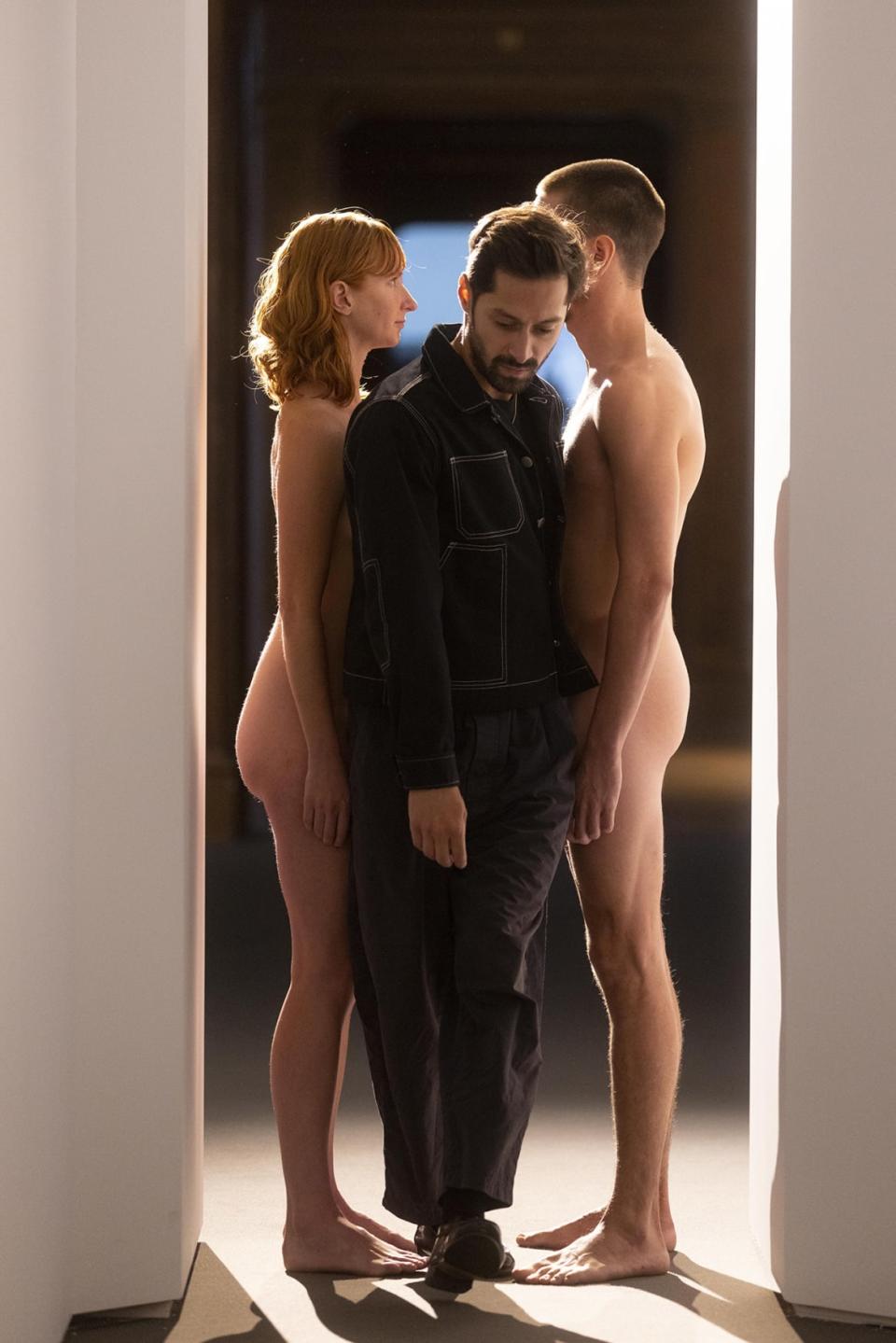
Marina Abramović's Imponderabilia at the Royal Academy of Arts.
A truism of performance art is that a piece’s particularities cannot be repeated—not exactly—because they are dictated by the time, place, and participants involved. This iteration of Imponderabilia in London illustrated the point perfectly, in that it had a distinctly British quality. Without being told to do so, my fellow gallery-goers and I foisted a sense of normalcy on proceedings by reverting to an institution as beloved and constitutionally English as the Ritz Hotel standing opposite the RA: we started queuing.
When it came my turn to go through, I was forced to contemplate the same “question of etiquette” posed by Brad Pitt in Fight Club as he rises from his airplane seat next to Ed Norton: “As I pass, do I give you the ass or the crotch?” Only in this instance, the essential horror is that the performers are going to have to get the ass and the crotch—it’s just a matter of who gets what.
Choosing which person to face as you brush past them—and why you make that choice, and not the other—is, I think, The Point. And for the avoidance of doubt, the models are standing about a foot or so apart. You’re not touching them a little bit—you really have to push your way between them. A full interrogation of the socio-psychological forces which ultimately inform my personal decision to face the man as I hurriedly squeeze through is beyond the scope of this article.
But really, it seemed almost arbitrary. It might have been that, without realizing, I simply copied what others had done before me. (At least one of the nude performers in the exhibition says that, contrary to her own expectations, most men choose to face the male performer, and most women the female.)
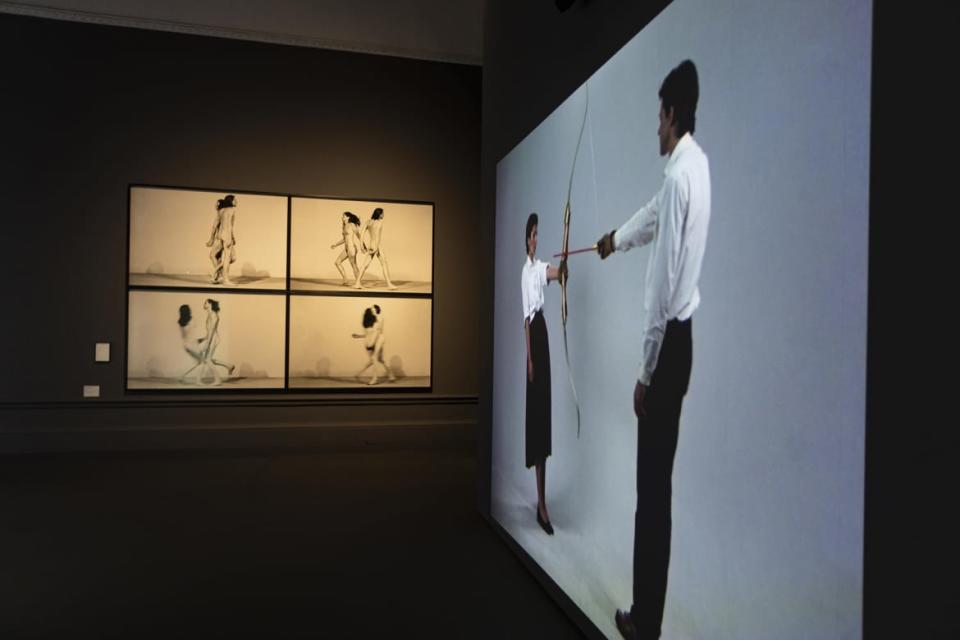
A gallery view of the Marina Abramović exhibition at the Royal Academy of Arts.
I also didn’t realize, until it was much too late, that the performers being repeatedly bumped, joggled, and cajoled by the visitors meant that they returned to slightly different standing positions after each person passed through. Sometimes they’d end up further apart, and sometimes they were closer together.
So it wasn’t until I was walking up that I clocked that they were actually much closer together than they had been for the three or four people who went ahead of me. It was going to be like pushing a beanbag through a mailbox.
I resolved to just try and shamble through as quickly as possible, with the whole experience probably lasting about a second, but time has a way of elongating when you’re having whatever is the opposite of fun. I often try to combat my debilitating fear of heights by thinking “don’t look down” when confronted with a deep drop, and found myself clinging to the same logic as I wedged myself between the performers, with my hands up surrender-style to avoid inadvertent touching, looking straight ahead and absolutely definitely not even for a single moment making eye-contact with either of them. But there’s something about the feeling of a stranger’s penis scraping against your leg and another’s breast simultaneously brushing your back that really rattles your determined unflappability.
The models, for their own part, didn’t even flinch. They continued to stare at each other as I broke their laser-like gaze. Spare a thought for these incredibly courageous people. Knowing how embarrassing and uncomfortable it is to be on the clothed side of the equation, God only knows how they get out of bed in the morning knowing that’s what they’re going to be doing with their day.
Because I, for one, hated it. I hated the idea of it, hated doing it, and hated having done it afterward. “Hate” is obviously a strong word, but I don’t think there’s a weaker one that will do. It also made me wish that, despite it being a reasonably warm evening (for London in September, at least), that I’d thought to dull the experience by wearing a sweater and coat, or—in an ideal world—a full suit of medieval armor to really insulate myself from the experience.
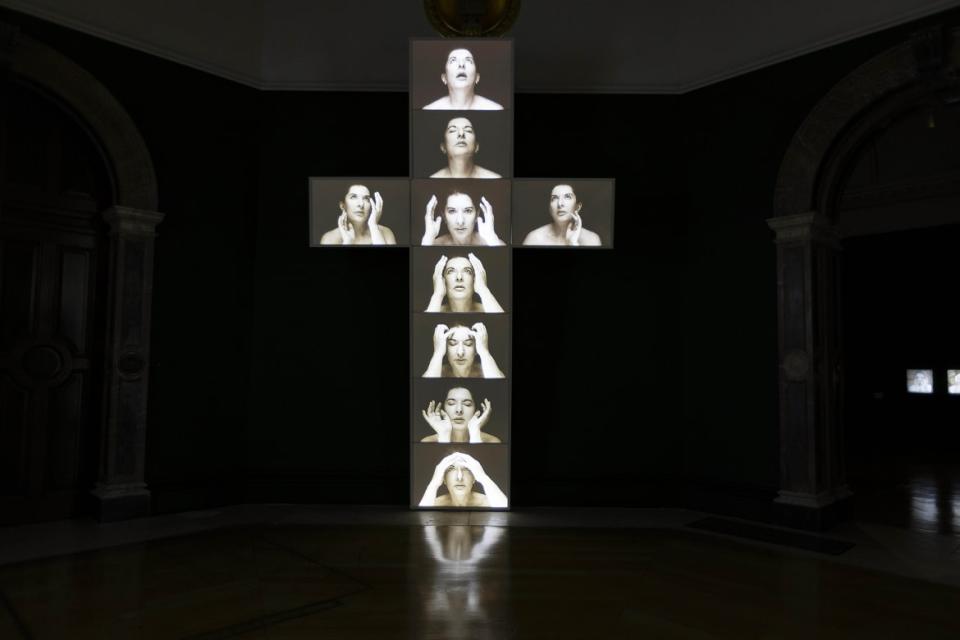
Marina Abramović's Four Crosses detail at the Royal Academy of Arts.
What’s interesting though, when you’re on the other side of the ordeal, is looking back and seeing the spectacle of how others choose to go through. Again, there’s a marked and unanticipated British aspect to the performance illustrated by the amount of people who, with polite embarrassment, say “sorry” to the naked man and woman, as though the performers hadn’t been expecting a cavalcade of strangers to awkwardly make contact with their sex organs.
As with The Artist Is Present, some people can’t suppress the laughter at how toe-curlingly weird the experience is. Others remain stoic, pushing themselves through the pair stony-faced, the way a particularly tight choke point in a cave might be navigated by spelunkers.
Some people prudishly choose to bypass the whole fleshy business altogether, taking an alternative passageway—which isn’t partially blocked by naked strangers—to the side of the main entrance, seemingly satisfied they get The Point without having to actually experience it firsthand. One guy, who seemed to linger a little longer than anyone else while wedged between the nudes, emerged on the other side smiling, then alarmingly headed back through the prudes’ passageway to return to the original entrance for what I didn’t hang around long enough to confirm what I suspected was an inexplicable second go.
Most people, having crossed the rude Rubicon, spoke excitedly with their fellow visitors at the other end about what they’d all just been through, and the gallery was abuzz with gleeful giggling. It’s true, traumatic experiences can end up bringing people together.
Passing through Imponderabilia, the exhibition continues with Abramović’s later work, which is altogether less brutal and, in some cases, downright daft (there’s talk of the “energy and curative power” of crystals, which is all a bit Goop-y). One piece asks that visitors place their heads on mounted blocks, creating the strange spectacle of fully grown adults standing and facing the gallery walls like children who have been ordered to do so for being naughty.
Elsewhere, there’s a copper bathtub filled with camomile flowers, for some reason, and a video recreation of The House with the Ocean View (2002) in which Abramović lived in Sean Kelly Gallery for 12 days eating nothing, saying nothing, and drinking only pure mineral water. The piece was recreated in the sixth season of Sex and the City. “When I was working in the galleries, performance art was more theater than installation—she’s moved it to the next level,” Charlotte says as she and Carrie watch. “Well, girlfriend needs to move a comb through her hair,” Carrie replies. “She has company.”
An introductory message at the RA exhibition reads: “By pushing the limits of her body and mind to extremes, Marina Abramović has captivated audiences for over fifty years.”. It’s true enough that you will be captivated—moving through such a menagerie of mutilation and discomfort, it’s literally impossible to be bored.
And if the point of art is to be thought-provoking, this exhibition also emphatically delivers, raising a series of urgent reflections such as “am I committing an arrestable offense right now?” or “What is the point of this?” and of course “Is this really art?” More than a century has passed since Marcel Duchamp famously flipped a urinal on its side, signed it, and, in effect, told a stuffy art establishment of canvas and chisels to piss off. If nothing else, Abramović’s work shows that the question of what should really count as art still remains imponderable.
Get the Daily Beast's biggest scoops and scandals delivered right to your inbox. Sign up now.
Stay informed and gain unlimited access to the Daily Beast's unmatched reporting. Subscribe now.

